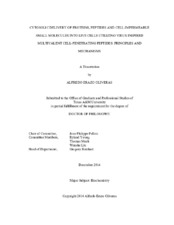| dc.description.abstract | Cell-penetrating peptides (CPPs) facilitate the delivery of cell-impermeable macrmolecules across the plasma membrane of live cells. CPPs act as biological Trojan horses by hijacking and inducing endocytosis to enter cells, which leads to entrapment of these peptides inside endocytic organelles. However, the endosomolytic activity displayed by CPPs is very low and cargos/CPP-cargo conjugates typically remain trapped inside endosomes. As a result, cargos often cannot reach their intracellular targets and fail to exert a biological response. A possible solution to this problem is to increase the endosomolytic activity of CPPs by creating multivalent CPPs. This idea is based on the rationale that an increase in the local concentration of CPPs at the sites where CPPs interacts with their cellular components could lead to higher endosomolytic activity. Interestingly, the previous has been observed in nature. For example, viruses display multiple proteins on their surface in order to bind extracellular receptors efficiently, facilitate entry to cells and cause infection. In this work, I report a delivery methodology based on the CPP TAT, a peptide derived from the HIV-1 TAT protein. I demonstrate that a trimeric multivalent CPP, Fl-TAT3, penetrates live cells more efficiently that its dimeric and tetrameric counterparts and delivers different molecules inside cells. Moreover, I describe the generation of an improved multivalent endosomolytic agent, dfTAT. I show that dfTAT endosomolytic activity is highly efficient and can deliver proteins, peptides and cell-impermeable small molecules into the cytosolic space of live cells. I show that dfTAT-mediated delivery can be achieved in multiple cell types. Furthermore, dfTAT delivered multiple molecules inside cells simultaneously and more than once. Interestingly, the amount of cargo delivered into the cytosolic space of cells could be controlled. Remarkably, I demonstrate that dfTAT-mediated delivery did not significantly affect important cellular processes. In addition, I provide mechanistic insights involved in dfTAT cell penetration. I show that dfTAT escapes the endocytic pathway from late endosomes. Finally, I show that endosomal escape seems to require interactions between dfTAT and BMP, a phospholipid only found inside late endosomes. These collective insights should provide a basis for the development of improved delivery agents. | en |


